(Upload on December 13 2025) [ 日本語 | English ]
Mount Usu / Sarobetsu post-mined peatland
From left: Crater basin in 1986 and 2006. Cottongrass / Daylily
A rolling stone gathers no mossEmbryophyta (Cronquist)= mosses (bryophyta) + ferns (pteridophyta) + seed plants (spermatophyta)Moss (s.l.): = bryophytes Moss (s.s.): bryophytes = mosses + hornworts + liverworts*
= non-vascular terrestrial plants: no vascular tissues Apomixis (weak speciation) → population maintenance
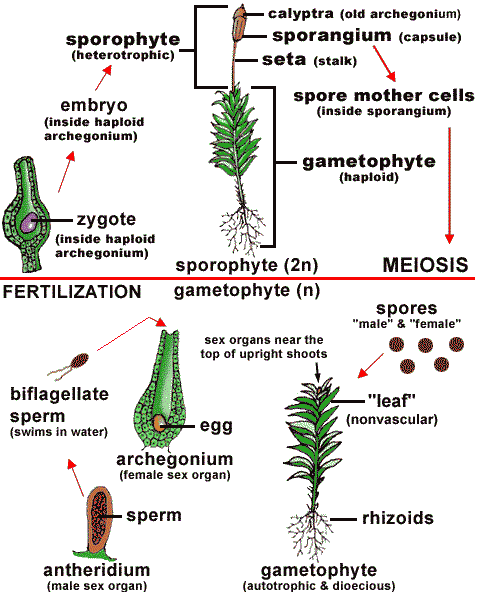
Sproe(n) → Protonema(n) → Juvenile(n)
↑R.D. ↓
Sporophyte(2n) → Mature plant (= Gametophyta, n):
↓ ♂ ♀ reproductive organ <─────┐
sexual reproduction (G) ↓ vegetative reproduction │
Mature plant ─────────┘
Fig. Life cycle of moss (→ fern)  Sporophytes(2n) grow on gametophytes(n) → nutrients are abosorbed by feet (足) on sporophytes → 2n parasitizes n = moss-typed life history |
[ species | Alaska ( feather moss )| plant taxonomy ( 植物分類学 )]
ChromosomeMusci: n = 5-60(120?), commonly having 10, 11 or 12Hepaticae: n = 4-32, commonly having 9 n of 40 species in Barrow (Alaska)
37 spp = 9 n of 50 species in the Magellan Strait
n = 9 for all the species n = 5 for 19 species measured The number of chromosome is extremely small of the terrestrial plants Takakia (ナンジャモンジャゴケ), liverwortsT. lepidozioides Hattori et Inoue ナンジャモンジャゴケ n = 4 (2V + 2J)
Two types of chromosomes, U and J
n = 4 → 8 → 8 + 1 → 18 → … The two morphological types, e.g., cell wall thicker in the type n = 5
Two species were established
T. lepidozoides: n = 5 = 2V + 2J + F → Takakia: the direction of evolution is likely to be decrease in chromosome numbers The stage having F chromosome shows the morphological traits of T. lepidozioides, although the n is 5 MorphologyDef. Rhyzoid (仮根): a root-like structure and function found in non-vascular plants (mosses, liverworts, algae and fungi) but unlike true roots, it lacks vascular tissue
function: anchorage and absorption (of water and nutrients) |
|
Class Musci (蘚類綱): Three subclasses = = Sphagnidae + Andreaeidae (クロゴケ) + Brydae (マゴケ) leafy moss gametophytes develop from a protonema a moss sporophyte consists of a capsule, seta and foot |
Protonema: a filament of n cells that grows from a spore and develops into leafy moss gametophytes in mosses Capsule: portion of the bryophyte sporophyte in which spores are produced |
SphagnaceaeSphagnum L. (ミズゴケ)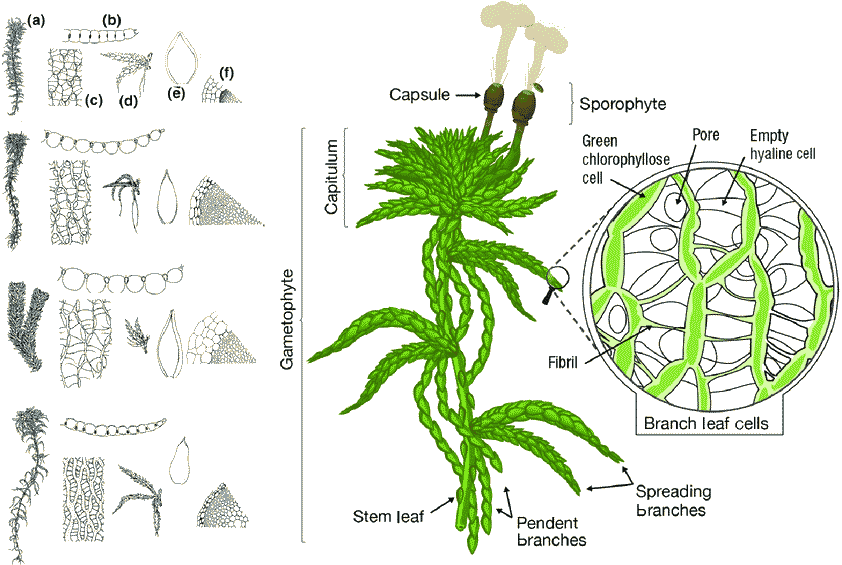 Fig. Morphological traits. Hyaline cell (透明細胞): non-photosynthetic, porous cells found in Sphagnum leaves Capitulum (頭部, pl. -a): compact clusters of branches on the top Species S. acutifolium Ehrh. ex Schrad. var. flavescens Warnst. (S. acutifolium Scop.* former name) S. acutum Warnst. var. hakusanense Warnst. ハクサンミズゴケ S. angustifolium (C.Jens.) C.Jens. アオモリミズゴケ* S. calymmatophyllum Warnst. et Card. コバノミズゴケ S. connectans Warnst. et Card. イトナシミズゴケ S. cuspidatum var. submersum Schimp. シワミズゴケ S. dicladum Warnst.ヤマミズゴケ S. drepanocladum Warnst. var. latilimbatum Warnst. ヘリトリミズゴケ S. fallax Klinngr. S. flexuosum Dozy et Molk. S. imbricatum Hornsch. ex Russ. フナガタミズゴケ (クシバミズゴケ*) var. affine (Ren. et Card.) Warnst. ハリマミズゴケ) S. incertum Warnst. et Card. ミネミズゴケS. jensenii Lindb. シナノミズゴケ* S. kushiroense H. Suzuki クシロミズゴケ |
S. lindbergii Schimp. ex Lindb. フサバミズゴケ S. majus (Russ.) C. Jens. S. magellanicum Bird. (ムラサキミズゴケ): 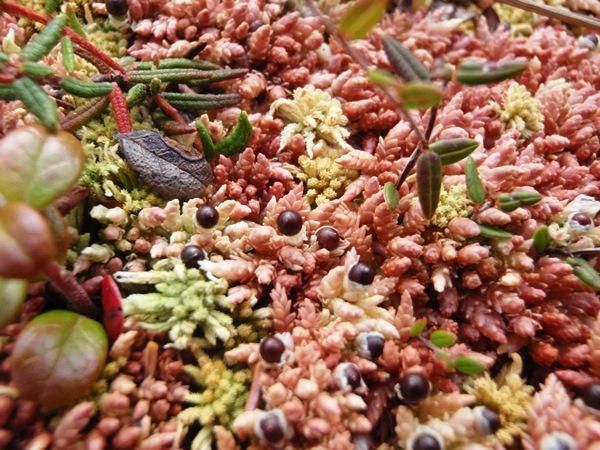 1 1
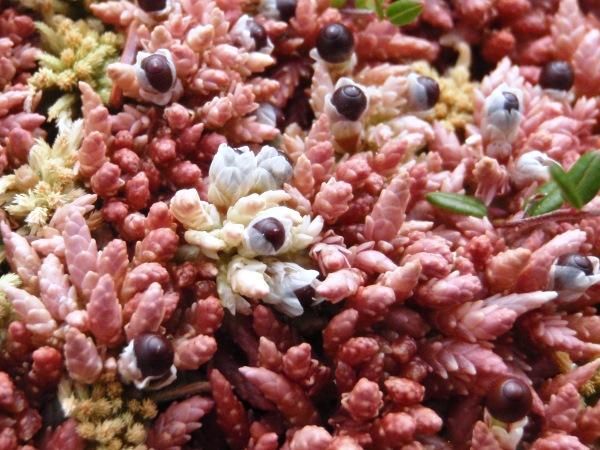 2 2
[1/2] in Poker Flat Research Range, interior Alaska, on August 12 2012. S. microporum Warnst. ex Card. コアナミズゴケ: aquatic, curved branches, small pores at the backside of transparent cell S. obtusum Warnst. S. pallens Warnst. et Card. シロミズゴケ S. palustre (オオミズゴケ), developing divergent branch (開出枝) and pendulous branch (下垂枝)
var. pallescens (Warnst.) Sak.ウスアオミズゴケ Distribution: boreal regions in the Northern Hemisphere (common in a post-mined peatland, Sarobetsu Mire, northern Hokkaido) 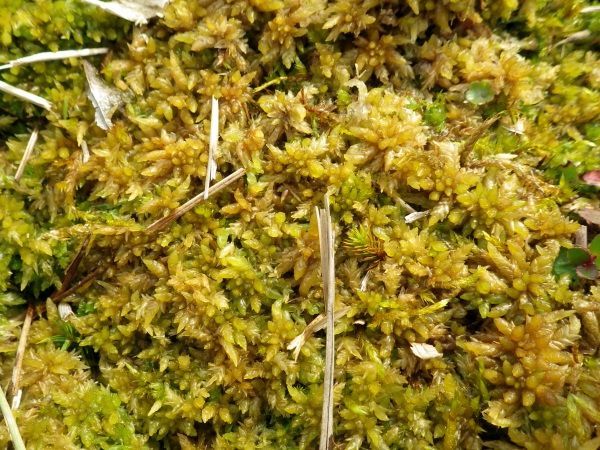 1 1
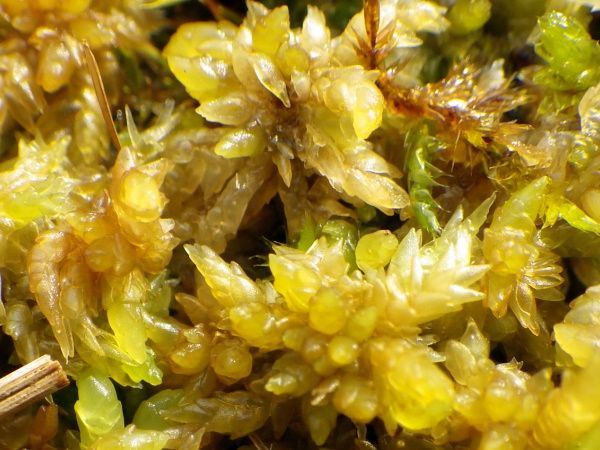 2 2[1/2] along the shore of Echigo Pond in Ebetsu City on October 8 2017.
var. confertum Lindb.フトミズゴケ S. plumulosum Roellワラミズゴケ* S. pulchrum (Lindb. ex Braithw.) Warnst. ウツクシミズゴケ |
S. quinquefarium (Lindb. ex Braithw.) Warnst.ゴレツミズゴケ S. recurvum P. Beauv.サンカクミズゴケ S. riparium Angstr.サケバミズゴケ* var. coryphaceum Russ.セイタカミズゴケ) S. rubellum Wils.ウスベニミズゴケ(アカミズゴケ*)S. russowii Warnst. S. septatum Warnst.フシミズゴケ S. squarrosum Crome (ウロコミズゴケ, spiky bog-moss) 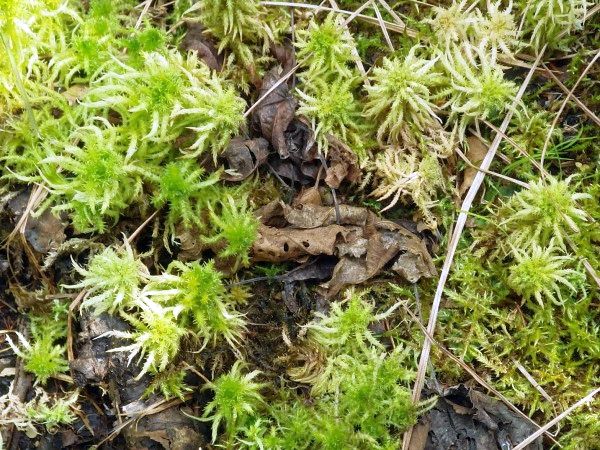 1 1
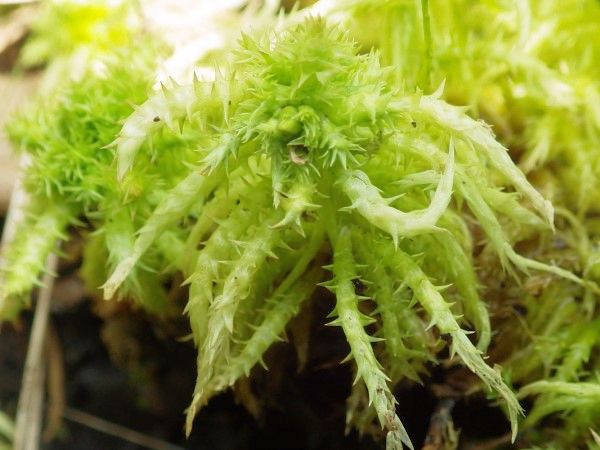 2 2[1] in a forest (Symbiosis Forest) near Nopporo Forest Park on May 5 2020. [2] on a wetland forest in the Shibecha Experimental Forest of Kyoto University, eastern Hokkaido, on June 27 2019. S. subacutifolium Schimp.スギバミズゴケモドキ S. subobesum Warnst.シタミズゴケ S. teres (Schimp.) Angstr. ex C.Hartm.ホソミズゴケ * S. tosaense Warnst. トサミズゴケ S. warnstorfii Russ.ワルンストロフミズゴケ 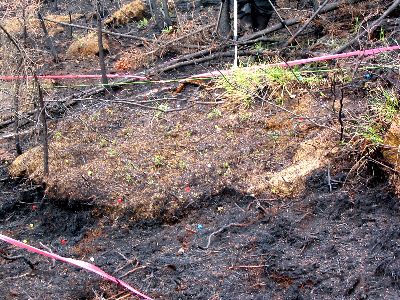
Sphagnum sheepResidual Sphagnum hummocks that survived fire activitySphagnum sheep provides safe sites for the seedling establishment of Picea mariana, and contributes micro-climate changes, such as albedo. |
|
Andreaeaceae Dumort. (クロゴケ) Acroschisma (Hook. f. et Wilson) Lindl. A. andensis Spruce, southern America Andreaea Hedw. (クロゴケ)Small, delicate acrocarpous mosses Forming dark brown or reddish cushions on wet siliceous rocks |
Order Tetraphidales (ヨツバゴケ)Order Fissidentales (ホウオウゴケ)Order Archidiales (ツチゴケ)Order Dicranales (シッポゴケ)Ditrichanceae (キンシゴケ)Ceratodon purpureus (Hedw.) Brid. (ヤノウエノアカゴケ) 1 1
 2 2
Distribution: cosmopolitan (Ceratodon consists of a few species but is one species in Japan) Habitat: disturbed sites (becoming common soon after wildfire and eruption) Order Pottiales (センボンゴケ)Pottiaceae (センボンゴケ)25 species in JapanBarbula Hedw. (ネジクチゴケ) B. unguiculata Hedw. (ネジクチゴケ), n = 13 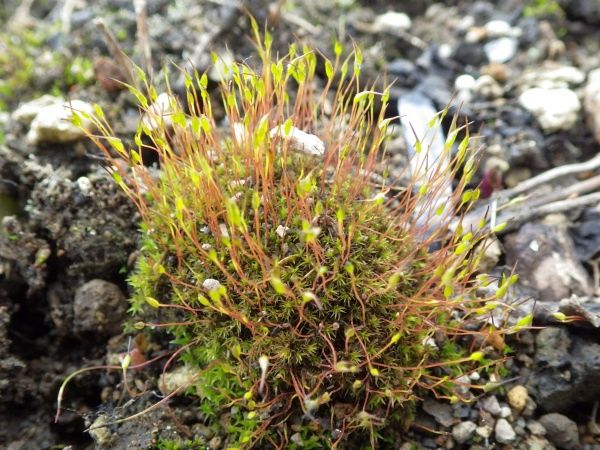

in a house garden, N14/W3, North Ward, Sapporo, on April 13 2018. Order Grimmiales (ギボウシゴケ)Grimmiaceae (ギボウシゴケ)Aligrimmia R. S. WilliamsBucklandiella Roiv. Codriophorus P. Beauv. Coscinodon Spreng. Coscinodontella R. S. Williams Dryptodon Brid. Gasterogrimmia (Schimp.) Buyss. Grimmia Hedw. Glyphomitrium Bridel G. humillimum (Mitt.) Card. (サヤゴケ) 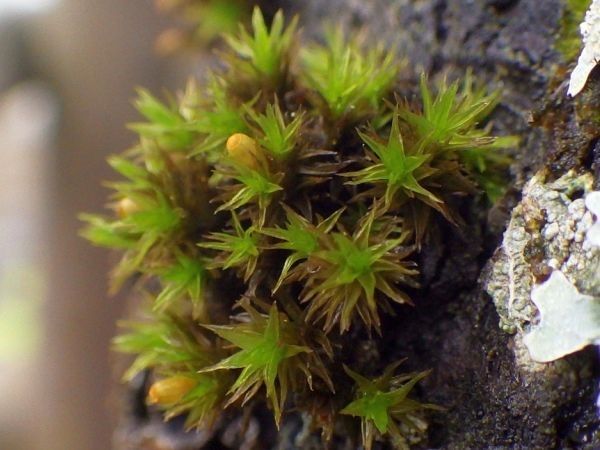
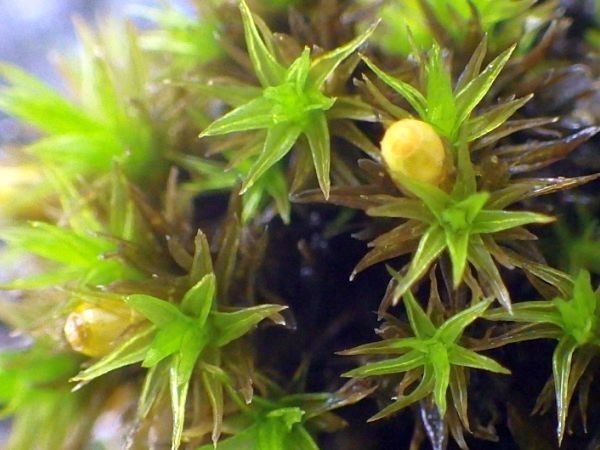 Distribution: widespread in the East Asia, including the whole of Japan
Distribution: widespread in the East Asia, including the whole of JapanHabitat: on bark Guembelia Hampe Indusiella Broth. et Müll. Hal. Jaffueliobryum Thér. Leucoperichaetium Magill Niphotrichum (Bedn.-Ochyra) Bedn.-Ochyra et Ochyra Orthogrimmia (Schimp.) Ochyra et Żarnowiec Racomitrium Brid. (シモフリゴケ) R. lanuginosum (Hedw.) Brid. (シモフリゴケ) 
 Distribution: widespread in the world (incluidng Mount Koma) Habitat: developing large carpets on soils and rocks Schistidium Bruch et Schimp. Scouleria Hook. Streptocolea (I. Hagen) Ochyra et Żarnowiec Tridontium Hook. f. Order Funariales (ヒョウタンゴケ)Splachnaceae (オオツボゴケ)60 species in 7 generaFunariaceae Schwägr. (ヒョウタンゴケ)300 species in 13 negeraFunaria hygrometrica Hedw. (ヒョウタンゴケ) 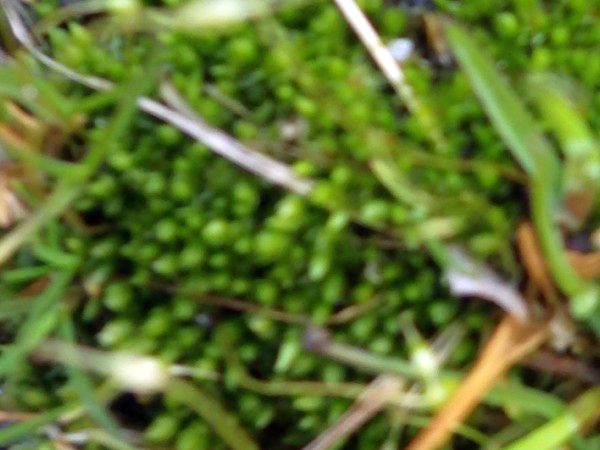
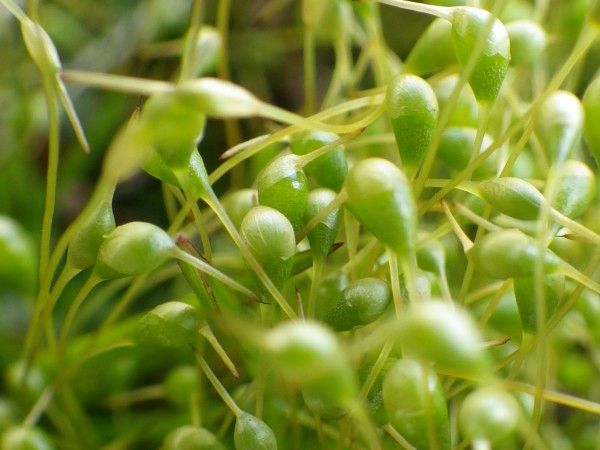
Disceliaceae Schimp. (ヨレエゴケ)One species Discelium nudum (ヨレエゴケ), known as flag-mossEphemeraceae (カゲロウゴケ)moved into Order Pottiales (センボンゴケ)Gigaspermaceae (ハイツボゴケ)separated to Order GigaspermalesOrder Schistotegales (ヒカリゴケ)Order Eubryales (ホンマゴケ)Bryaceae (カサゴケ)
Bryum Hedw. (ハリガネゴケ) |
Polia Hedw. (ヘチマゴケ) P.E nutans (Hedw.) Lindb. (ヘチマゴケ) 
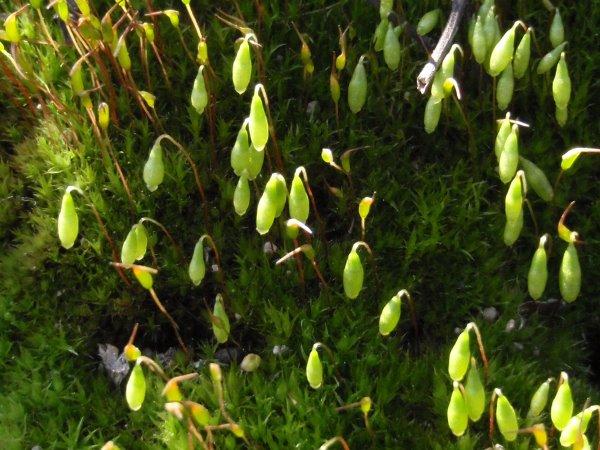 on a concrete fence near a post office, N14/W5, North Ward, Sapporo, on May 8 2013. P. flexuosa Hook. (ケヘチマゴケ) 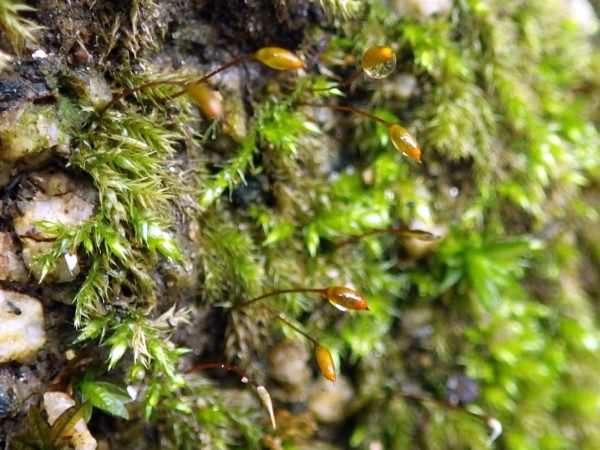
 Mniaceae Schwägr. (チョウチンゴケ)Plagiomnium T. J. Koponen (ツルチョウチンゴケ)Plagiomnium acutum (Lindb.) T. J. Kop. (コツボゴケ) Distribution: widespread in eastern Eurasia, including the whole of Japan Habitat: on soil and rock 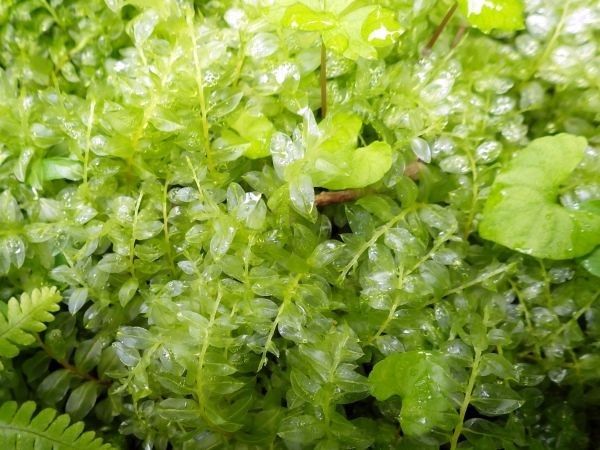
 Pohlia Hedw. (ヘチマゴケ) Bartramiaceae Schwägrichen (タマゴケ) Bartramia Hedw. (タマゴケ) B. pomiformis Hedw. (タマゴケ) Distribution: broadly distributed in the Northern Hemisphere (east Asia - Siberia - Europe - North America) Habitat: developing colonies on soils and rocks Chromosome number: n = 8 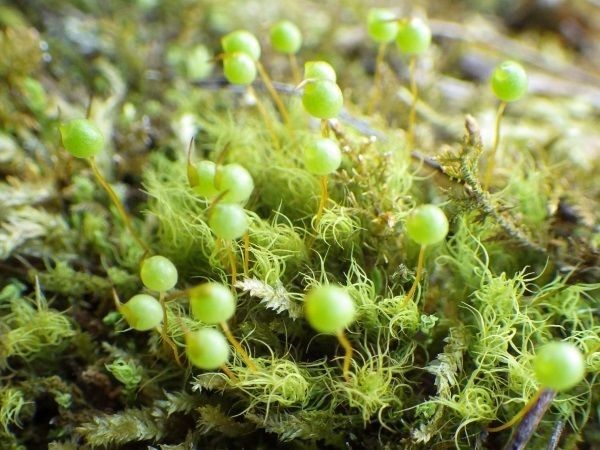
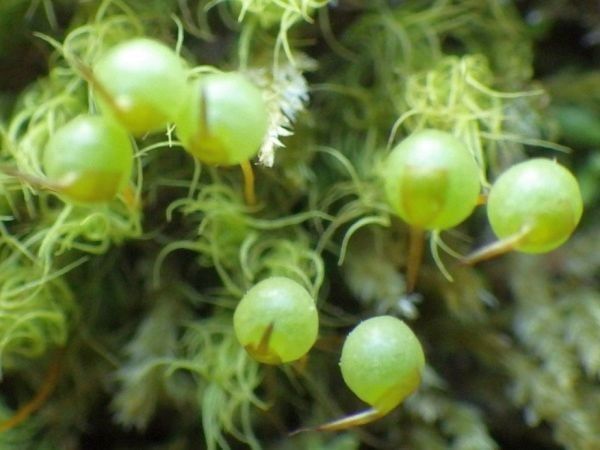
on Oshima Island in Matsushima Islands, northern Honshu, on March 21 2016. Order Orthotrichales (タチヒダゴケ)controversial group Order Isobryales (イヌマゴケ)Climaciaceae (コウヤノマンネングサ)C. japonicum Lindberg (コウヤノマンネングサ) Chromosome number: n = 11 
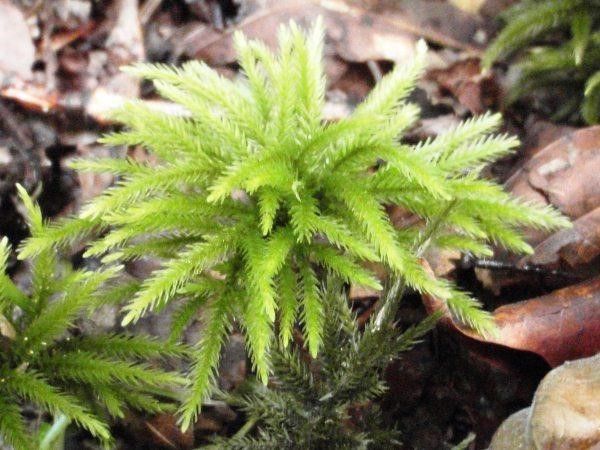
in Tomakomai Experimental Forest on August 23 2012. A few picture books describe that ths plant is beautiful. Order Hookeriales (アブラゴケ)Order Hypnobryales (シトネゴケ)Theliaceae (ヒゲゴケ)Fabroniaceae (コゴメゴケ)Leskeaceae (ウスグロゴケ)Thuidiaceae (シノブゴケ)Abietinella C. Muell. (モミシノブゴケ)Anomodon Hook. et Tayl. (キヌイトゴケ) Boulaya Card. (チャボスズゴケ) Clapodium (Lesq. et James) Ren. et Card. (ハリゴケ) Haplocladium (コバノキヌゴケ) H. angustifolium (Hampe et Mull. Hal.) Broth. (ノミハニワゴケ) 
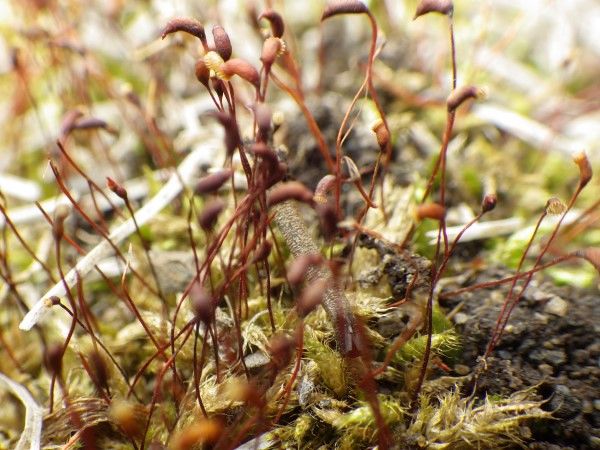 in front of GSEES, HU, on April 12 2019. Miyabea Broth. (ミヤブゴケ) Thuidium B.S.G. (シノブゴケ) Amblystegiaceae (ヤナギゴケ)Brachytheciaceae (アオギヌゴケ)Brachytecium (ネズミノオゴケ)Bryhnia Kaurin B. novae-angliae (Sull. et Lesq.) Grout (ヤノネゴケ) 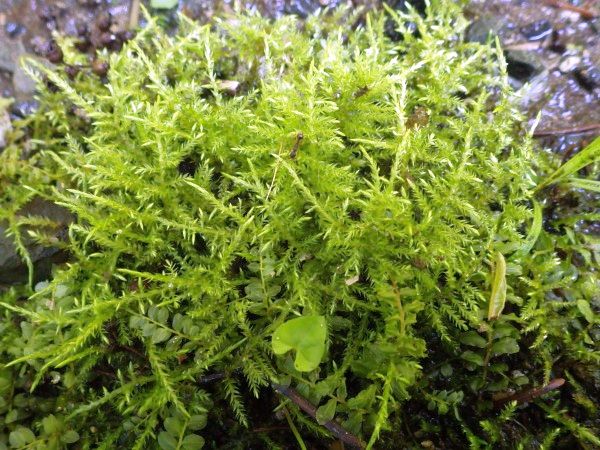
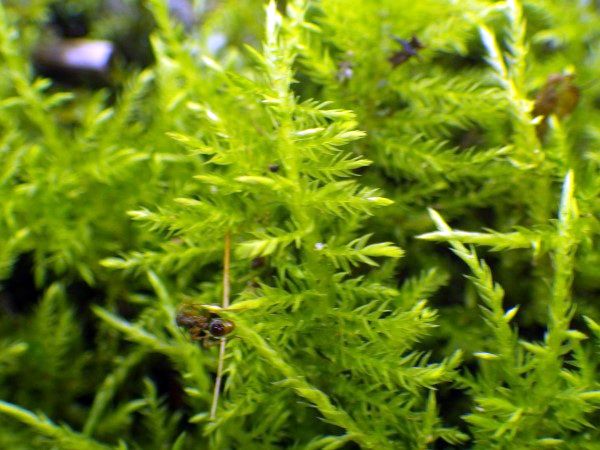 Distribution: temperate and cool-temperate regions in the Northern Hemisphere Habitat: moist and wet habitats, occasionally in water [1/2] in the Furano Experimental Forest of the University of Tokyo, central Hokkaido, on June 28 2017 Homalothemium Myuroclada Rhynchostegium Entodontaceae (ツヤゴケ)Plagiotheciaceae (サナダゴケ)Sematophyllaceae (ハシボソゴケ)Hypnaceae (ハイゴケ)Rhytidiaceae (フサゴケ)Hylocomiaceae (イワダレゴケ) |
Order Buxbaumiales (キセルゴケ)Buxbaumiaceae (キセルゴケ)pioneer species on successionBuxbaumia Hedw. (キセルゴケ), bug moss |
Diphascum Diphyscium D. Mohr (イクビゴケ) Muscoflorschuetzia Theriotia (クマノゴケ) |
Order Polytrichales (スギゴケ)Polytrichacae (スギゴケ)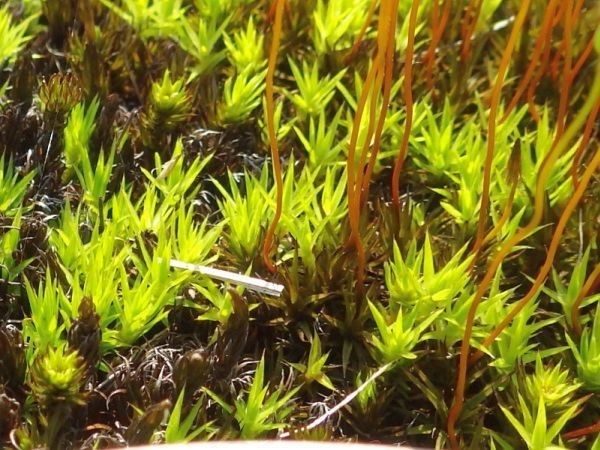 1 1
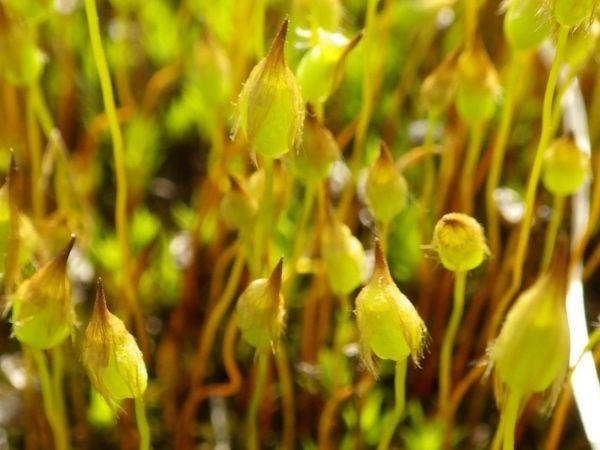 2 2Polytrichum juniperinum Willd. ex Hedw. (juniper haircap or juniper polytrichum moss, スギゴケ)[1/2] in a post-mined peatland, Sarobetsu mire on May 22 2016.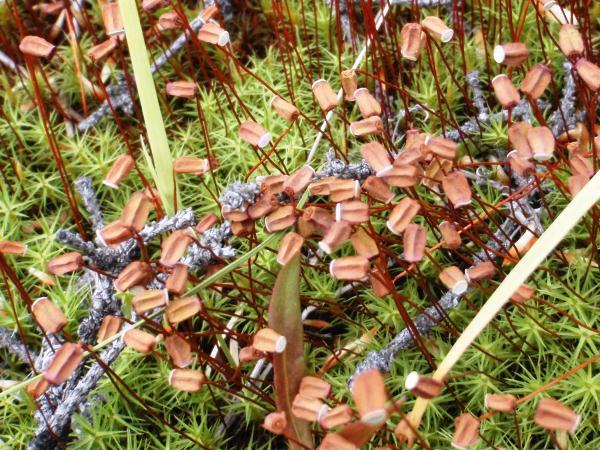 1 1
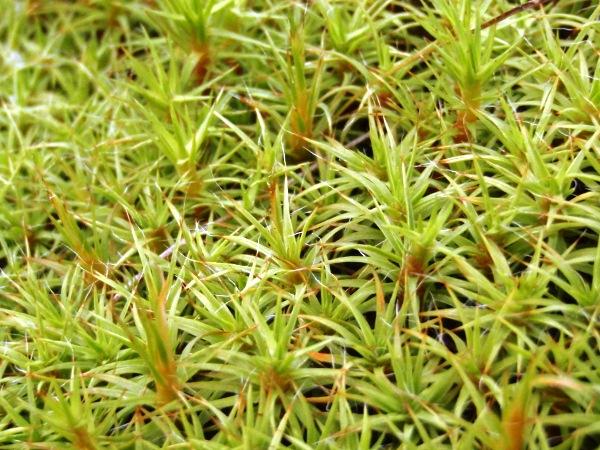 2 2Polytrichum commune Hedw. (Common haircap moss, ウマスギゴケ) |
[1/2] at Poker Flat that was burned in the summer of 2004, Fairbanks, AK, on August 10 2012. This species is widespread on the site , as a pioneer on succession (Tsuyuzaki et al. 2009) Other common names: common haircap, great golden maidenhair, great goldilocks, common haircap moss or common hair moss Distribution: throughout temperate and boreal regions in the Northern Hemisphere and several Pacific Islands including New Zealand, and in Australia Habitat: in bogs, wet heathland and along forest streams xeromorphic adaptation  1 1
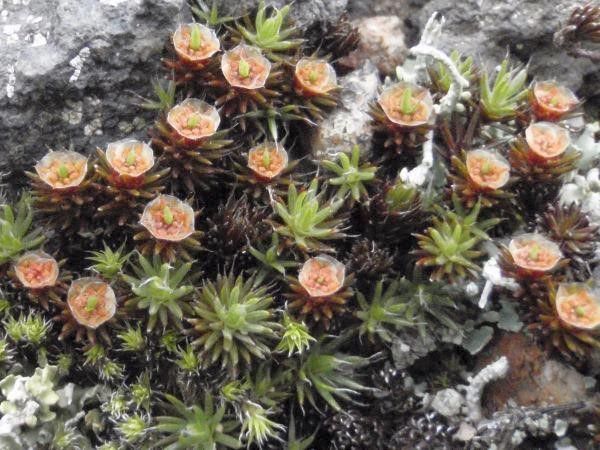 2 2Polytrichum piliferum Hedw. (Bristly haircap, ハリスギゴケ)[1/2] clsoe to an area damaged by the volcnaic eruptions in 1996 on the summit of Mount Koma, southern Hokkaido, on July 7 2013. n = 7. The annual fluctuation of plant cover was highly variable in plots established on the mountain.Order DawsonialesDawsoniaceae |
Morphology
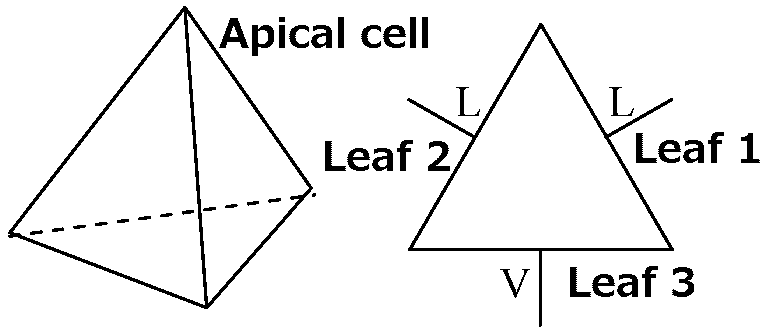 L: lateral merophyte, V: ventral merophyte Phylogeny(Inoue 1975) Class Hepaticae (苔類綱)Subclass Calobryidae (コマチゴケ亜綱)Order TakakialesTakakiaceae Takakia Order Calobryales Haplomitriaceae Ded. (コマチゴケ) Subclass Jungermanniidae (ウロコゴケ亜綱)Order Metzgeriales (Anacrogynae) フタマタゴケlack air chambers, pores, ventral scales gametangia and sporophytes are sessile on the gametophyte elevation of the capsule (sporangium) is accomplished by elongation of the seta (stalk) of the sporophyte sporangia contain elaters Order Jungermanniales (Acrogynae) (ウロコゴケ, leafy liverworts) dorsiventral growth habit two rows of lateral leaves and one row of ventral leaves (amphigastria) Plagiochilaceae Müll. Frib. (ハネゴケ) characterized by perianths laterally compressed, bilabiate and wide-mouthed sex organs not in specialized positions capsule walls many-stratose; and seta thick 1600 species in the world, many endemic species all species in Hawaii are endemic Acrochila: A. caledonica (Steph.) InoueChiastocaulon dendroides (Nees) Carl Plagiochila: P. spinulosa (Dicks.) Dum., P. wakawana Steph., P. subopposita Steph. Plagiochilion: P. bryhnii (Steph.) Inoue, P. oppositus (Reinw., Blume et Nees) S. Hatt., P. fimbriatus (Mitt.) Inoue |
Subclass Marchantiidae (ゼニゴケ亜綱)450 species and 27 genera in 12 families in the world (39 species and 18 genera in nine families in Japan)Conocephalaceae (ジャゴケ) Conocephalum conicum (L.) Dum. (ジャゴケ), 1属1種 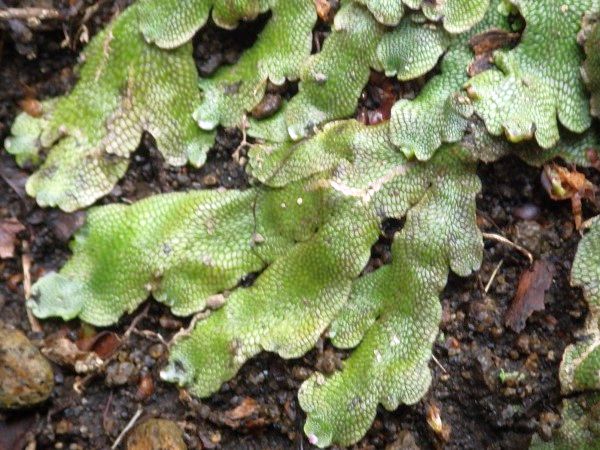
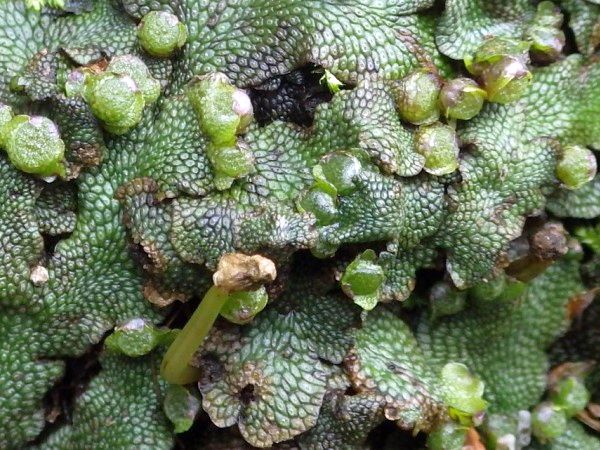
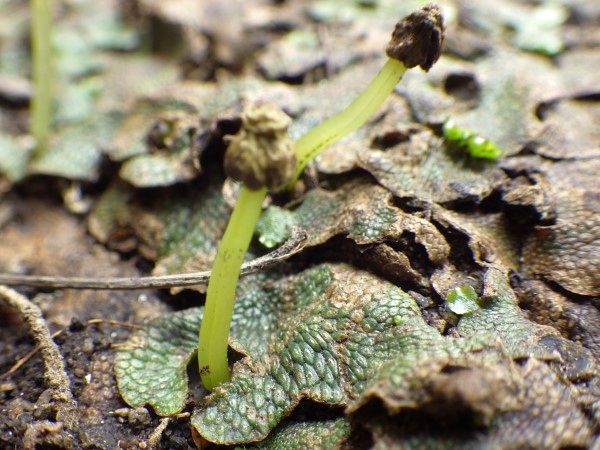 Fig. C. conicum at the backyard of GSEES, HU. Left/Center, on May 1 2021. Right, on April 22 2022 Marchantiaceae (ゼニゴケ) Marchantia L. (ゼニゴケ), merged with Bucegia Radian and Preissia Corda M. polymorpha L. (ゼニゴケ, common liverwort) female plant with archegoniophores / Male plant with antheridiophores gemmae cups dorsal surface of thallus showing air chamber outlines and pores 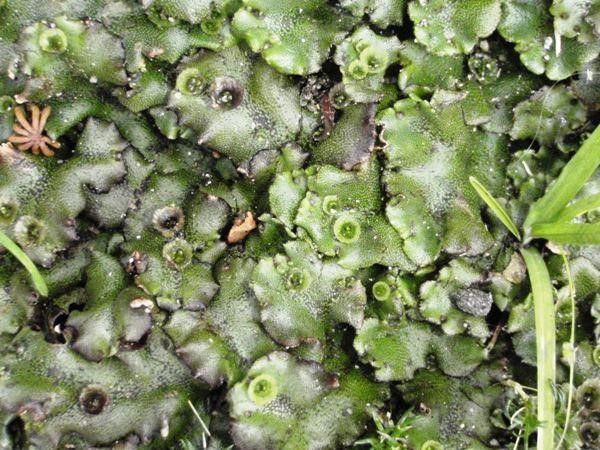
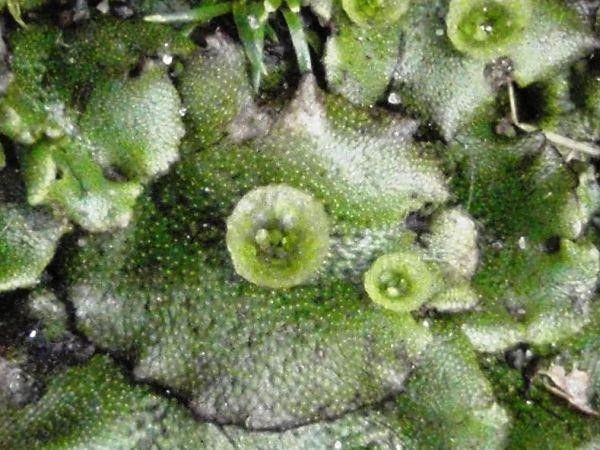
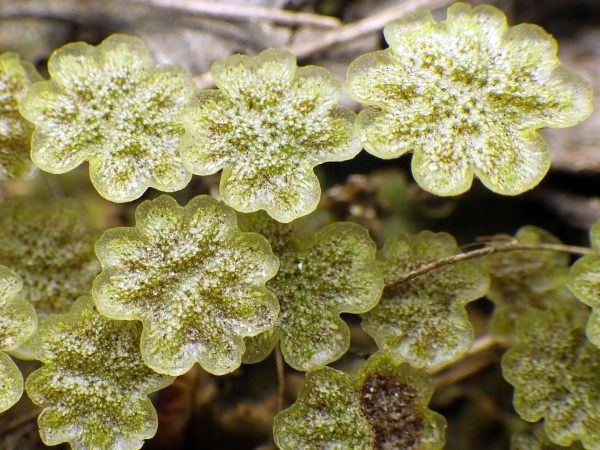 Fig. (left/center) M. polymorpha: at a roadside in the city of Sapporo (N22/W2, East Ward) on October 26 2009. This species is common in various habitats, e.g., volcanoes and post-fire forest, as a pioneer on succession. (right) antheridiophore at a roadside in N27/E2, Sapporo, on May 1 2018. M. papillata Raddi. ssp. grossibarba (Steph.) Bischl. (Syn. M. tosana Steph.): This species had been reported from the west of Kanto District, and was recorded from Mt. Usu, Hokkaido, northern Japan. The subspecies grows on soil around fumaroles in the mountain. (樋口・露崎 2023) Ricciaceae (ウキゴケ): Riccia (ウキゴケ): most species are terrestrial → R. fluitans: amphibious, by large air chambers in the thallus Ricciocarpus (イチョウウキゴケ)
antheridia and archegonia - (monoecious) |
|
≈ 150 species (17 species in 6 genera reported from Japan)
lifeform: most species are evergreen perennial has an intercalary meristem, so can grow indeterminately gametophyte: thalloid
having stoma-like structures, the only known occurrence in a gametophyte archegonia (造卵器): embedded in the thallus and in contact with surrounding vegetative cells cavity: filled with mucilage containing Nostoc = nitrogen-fixer TaxonomyClass Leiosporocerotopsida Stotl. & Crand.-Stotl. (スジツノゴケ)Order Leiosporocerotales Hässel (スジツノゴケ)Leiosporocerotaceae Hässel ex Ochyra (スジツノゴケ)Leiosporoceros Hässel (スジツノゴケ) Class Anthocerotopsida Jancz. (ツノゴケ)Subclass Anthocerotidae Rosenv. (ツノゴケ)Order Anthocerotales Limpr. (ツノゴケ)Anthocerotaceae Dumort. (ツノゴケ)Anthoceros L. (ナガサキツノゴケ/ツノゴケ) Folioceros D. C. Bharadwaj (ミヤベツノゴケ) Sphaerosporoceros Hässel |
Subclass Notothylatidae R. J. Duff, J. C. Villarreal, Cargill et Renzaglia (ツノゴケモドキ)Order Notothyladales Hyvönen et Piippo (ツノゴケモドキ)Notothyladaceae Müll.Frib. ex Prosk. (ツノゴケモドキ)Subfam Notothyladoideae Grolle (ツノゴケモドキ) Notothylas Sull. ex A. Gray (ツノゴケモドキ) Phaeocerotoideae Hüssel (ニワツノゴケ) Phaeoceros Prosk. (ニワツノゴケ) Paraphymatoceros Hässel Hattorioceros (J. Haseg.) J. Haseg. Mesoceros Piippo Subclass Dendrocerotidae R. J. Duff, J. C. Villarreal, Cargill et Renzaglia (キノボリツノゴケ)Order Phymatocerotales R. J. Duff, J. C. Villarreal, Cargill et Renzaglia (ナガイモツノゴケ)Phymatocerotaceae R. J. Duff, J. C. Villarreal, Cargill et Renzaglia (ナガイモツノゴケ)Phymatoceros Stotl., Doyle et Crand.-Stotl. (ナガイモツノゴケ) Order Dendrocerotales T. Katag. et Furuki (キノボリツノゴケ)Dendrocerotaceae J. Haseg. (キノボリツノゴケ) Subfam Phaeomegacerotoideae R. J. Duff, J. C. Villarreal, Cargill et Renzaglia (ミナミツノゴケ)Phaeomegaceros R. J. Duff, J. C. Villarreal, Cargill et Renzaglia (ミナミツノゴケ) Subfam Dendrocerotoideae R. M. Schust. (キノボリツノゴケ) Nothoceros (R. M. Schust.) J. Haseg. Dendroceros Nees (キノボリツノゴケ) Megaceros Campb. (アナナシツノゴケ) |
Comparative cryptogam ecology, in particular bryophyte and lichen (Cornelissen et al. 2007)
|
|
Moss flora list on Poker Flat (after the 2004 wildfire)The specimens are stored in SAPS. Thank Dr. Higuhi for the identification!
|
Feather moss
Cf. Red-stemmed feather moss (or, Boreal feather moss) = Pleurozium schreberi [tachihaigoke, タチハイゴケ] |